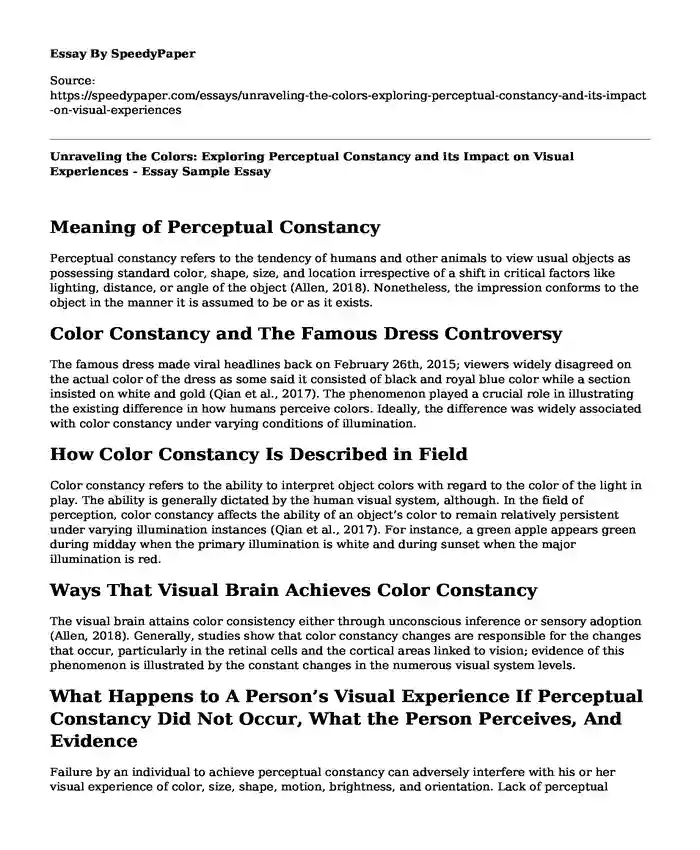Meaning of Perceptual Constancy
Perceptual constancy refers to the tendency of humans and other animals to view usual objects as possessing standard color, shape, size, and location irrespective of a shift in critical factors like lighting, distance, or angle of the object (Allen, 2018). Nonetheless, the impression conforms to the object in the manner it is assumed to be or as it exists.
Color Constancy and The Famous Dress Controversy
The famous dress made viral headlines back on February 26th, 2015; viewers widely disagreed on the actual color of the dress as some said it consisted of black and royal blue color while a section insisted on white and gold (Qian et al., 2017). The phenomenon played a crucial role in illustrating the existing difference in how humans perceive colors. Ideally, the difference was widely associated with color constancy under varying conditions of illumination.
How Color Constancy Is Described in Field
Color constancy refers to the ability to interpret object colors with regard to the color of the light in play. The ability is generally dictated by the human visual system, although. In the field of perception, color constancy affects the ability of an object’s color to remain relatively persistent under varying illumination instances (Qian et al., 2017). For instance, a green apple appears green during midday when the primary illumination is white and during sunset when the major illumination is red.
Ways That Visual Brain Achieves Color Constancy
The visual brain attains color consistency either through unconscious inference or sensory adoption (Allen, 2018). Generally, studies show that color constancy changes are responsible for the changes that occur, particularly in the retinal cells and the cortical areas linked to vision; evidence of this phenomenon is illustrated by the constant changes in the numerous visual system levels.
What Happens to A Person’s Visual Experience If Perceptual Constancy Did Not Occur, What the Person Perceives, And Evidence
Failure by an individual to achieve perceptual constancy can adversely interfere with his or her visual experience of color, size, shape, motion, brightness, and orientation. Lack of perceptual constancy means an individual is not able to organize sensations into significant perceptions (Allen, 2018). As a result, it is hard for the person to perceive items as stable regardless of the shifting images they form on the retinas. Evidence can be seen in the metacognitive theory, where children with less perceptual constancy make inaccurate estimates on distant objects as opposed to adults with high perceptual constancy (Allen, 2018).
References
Allen, K. (2018). Perceptual constancy and apparent properties. Phenomenal Presence, 39-57.
Qian, Y., Chen, K., Nikkanen, J., Kamarainen, J. K., & Matas, J. (2017). Recurrent color constancy. In Proceedings of the IEEE International Conference on Computer Vision (pp. 5458-5466). Retrieved on September 29th, 2020 from https://openaccess.thecvf.com/content_iccv_2017/html/Qian_Recurrent_Color_Constancy_ICCV_2017_paper.html
Cite this page
Unraveling the Colors: Exploring Perceptual Constancy and its Impact on Visual Experiences - Essay Sample. (2023, Dec 30). Retrieved from https://speedypaper.net/essays/unraveling-the-colors-exploring-perceptual-constancy-and-its-impact-on-visual-experiences
Request Removal
If you are the original author of this essay and no longer wish to have it published on the SpeedyPaper website, please click below to request its removal:
- Free Essay Containing Urban Planning Thesis Topics
- Passion as a Significant Factor of Dreams Achievement, Essay Example
- Rawls and Nozick on Gun Violence and Applicable Laws. Free Essay
- Essay Sample on The Flapper Counterculture
- Essay Sample on English Imperialism
- Free Essay Sample: Civil Rights Movement in United States
- Free Esaay Example on Mao Zedong: Economic and Cultural Transformation of China
Popular categories





